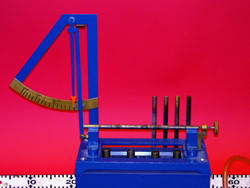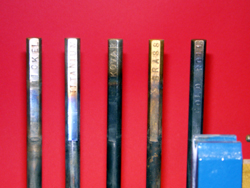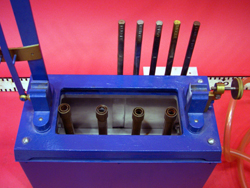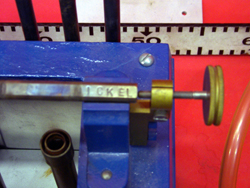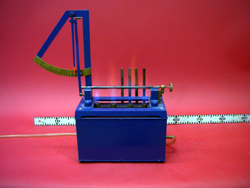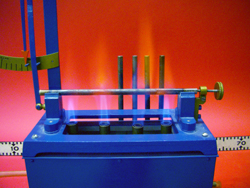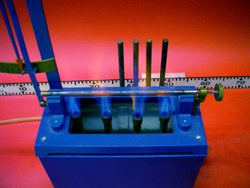Thermal Expansion of Metal Rods , 4A30.55a
Topic and Concept:
Thermal Properties of Matter, 4A30. Solid Expansion
Location:
Cabinet: Thermodynamics (TD)
Bay: (A3)
Shelf: #1
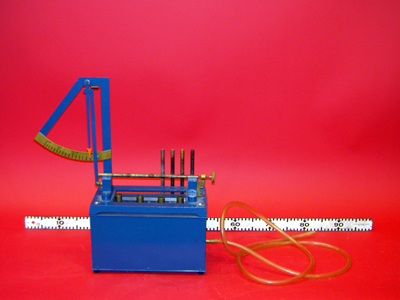
Abstract:
An apparatus holds rods of different materials while they are heated over a flame. Each rod expands linearly to different extents while heating.
Equipment |
Location |
ID Number |
|
|
|
Metal blue box with rods |
4A30.58 |
|
Safety gloves and glasses |
Drawer underneath microwave in lecture demo room |
|
Located in rooms 2103, 2241, (and 2223 upon request) |
|
Important Setup Notes:
This demonstration requires a supply of methane gas usually provided by the red and white gas carts found in rooms 2103, 2241, (and 2223 upon request).
Setup and Procedure:
- Choose a rod and place it on the holder.
- Connect the burner to the methane supply.
- Open the valve to let the gas flow, and light the burner using a match or lighter.
- Place the flame under the rod to heat it.
- Note the rate of expansion.
- Turn of the gas by closing the valve, and allow some time for the rod to cool.
- Carefully (using insulated gloves) switch out this rod for another one and repeat the heating process.
- Note that the rate of expansion for this different material is different from the first rod.
Cautions, Warnings, or Safety Concerns:
- Beware of the heated rods - they can cause serious burns!
- Wear the safety glove and glasses when the methane is burning and while the rods are hot.
Discussion:
A given material of given length (1D), area (2D), or volume (3D) will have different geometric size at different temperatures. The equations describing this behavior is
ΔL/L = αL*ΔT (1D) ΔA/A = αA*ΔT = αL2*ΔT (2D) ΔV/V = αV*ΔT = αL3*ΔT (3D)
where L, A, and V are the initial length, area, and volume respectively when the material has temperature Ti. The Δ denotes the change in that quantity (final - initial). αL, αA, αV are the linear, area, and volumetric coefficients of thermal expansion respectively. Note that for the 2D and 3D cases, equating αA to αL2 and αV to αL3 is only valid for small expansions (or contractions) in isotropic materials.
This demonstration shows that different materials have different coefficients of thermal expansion. We have five different material rods of equal length that start at room temperature and can be heated to the temperature of the flame. Thus, ΔT is the same for all the rods For one rod, you will see (using the scale) that ΔL increases at some rate during heating. When another rod is heated, its ΔL increases at a different rate. To show this difference most dramatically, compare the rate of increase of ΔL between kovar (our smallest αL) and brass (our largest αL).
Our available materials with their respective linear thermal expansion coefficients in ascending order
Material |
αL (x 10-6 K-1) |
Kovar |
5.5 |
Titanium |
8.6 |
Cold-rolled steel |
12.4 |
Nickle |
13.0 |
Brass |
18.7 |
|
|
|
|
|
|
|
|
Videos:
References:
